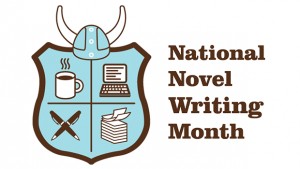 NaNoWriMo is short for National Novel Writing Month. Founded in 1999 with just 21 participants, the movement has grown to including nearly a million writers annually.
NaNoWriMo is short for National Novel Writing Month. Founded in 1999 with just 21 participants, the movement has grown to including nearly a million writers annually.
Each November, participants are encouraged to write an entire novel in just 30 days. The goal is to complete a very rough first draft, which will be edited throughout the following year. Participants start by registering on the NaNoWriMo website where they will be connected to a local Municipal Liaison (ML) who will inform them the dates and times of write-ins. The write-in is simply times when groups of local writers agree to meet for the purpose of diligently writing their novels.
NaNo Rules
- Writing starts at 12:00 a.m. on November 1st and ends 11:59:59 p.m. on November 30th, local time.
- Planning and extensive notes are permitted, but no material may be written before November 1st.
- Participants’ novels can be on any theme or genre of fiction.
- To “win” novels must reach a minimum of 50,000 words before the end of November. These words can either be a complete novel or the first 50,000 words of a novel to be completed later.
- “Rebelling” is allowed and rebels are able to receive prizes from sponsors.
10 Tips for NaNoWriMo Success
- Write a single sentence conceptualizing your story before you begin. To give yourself a solid framework, make sure to clearly define the protagonist and the ultimate goal.
- Know where the story ends and write to that purpose.
- Understand your world. If you are writing a period novel, then you need to understand the geography, infrastructure, and culture of the time. If you are writing a crime novel, you need to understand police procedure. If you are writing sci-fi or fantasy, it is important to make sure magical rules or technologies are consistent throughout the book.
- Create an outline or rough sketch of scenes or list elements that need to occur in each chapter. Having the basic story arc and plot worked out ahead of time will help keep you on track.
- Know your characters intimately. Create sheets detailing their strengths, weakness, and backstory. Sometimes what you know about the characters will help determine the story.
- Develop a suitable writing routine and set rules for when you must write. Some writers do better with several short writing sprints per day than a large dedicated block of writing time.
- Remember, you are writing a first draft. There will be mistakes, lots of them, so don’t try to edit as you go. Just get the story out of your head, there will be time to edit, revise, and even re-write later. If you get stuck, just follow the next logical step for your story, so you can keep writing.
- But, don’t ditch quality altogether. Your NaNoWriMo manuscript needs to be a story with a beginning, middle, and end. Disjointed stream-of-consciousness writing that is little more than mental regurgitation is not a novel. NaNoWriMo focuses on the discipline necessary to adhere to the writing process, which includes creating a complete story.
- Avoid the dreaded info-dump. Weave the backstory into your present story a little at a time through dialogue, dreams, or flashbacks. Revealing plot points through arguments or surprises will seem more natural for the reader than a clunky info dump. This will also help prevent heavy foreshadowing, in which the writer gives away the plot too soon, causing readers to lose interest.
- If you get writers block, be kind to yourself. Stop working on your novel and try writing something else for a little while. Focusing on something else will give your mental gears the time and space to get unstuck.
The Novel Factory has a number of worksheets to help you prep before beginning your novel. Some of my favorite worksheets are The Premise and The Skeleton because these help define the story arc.
If you are not up for writing a whole novel, be a NaNo Rebel. Rebels write everything except a novel in November. Rebelling can be a great way to introduce yourself to NaNoWriMo and the writing community without the pressure of having to finish a novel in 30 days. To make rebelling fun, I have created a NaNo Rebel Bingo sheet.

Community
The NaNoWriMo website has forums where participants can go for advice, information, support, and opportunities for “collective procrastination.”
The Municipal Liaisons (ML) volunteer their time to organizing local events. In addition to scheduling write-ins, MLs often plan a kickoff party and a TGIO (Thank God It’s Over) party to celebrate the success of completed novels. For those with a competitive edge, the Moscow-Pullman community engages in an annual “word war.” The winner is whichever municipality collectively writes the most words during November.
As November draws to a close, many NaNoWriMo participants often find themselves wondering, “I wrote a novel, so now what?”
The “Now What?” months are January and February. After taking the month of December off, participants are encouraged to begin self-editing and critiquing their novel early the following year, in hopes of getting it publisher ready before the next November. Do not take editing for granted. Always start with self-editing, then when the novel appears complete, have it critiqued by others. Only after it’s been through the self-editing and critique phases should you begin looking for a professional editor.
To encourage editing during the “Now What?” months, the Palouse Writers Guild is sponsoring a 1st chapter writing contest. You can learn more about the contest rules and deadlines on their website www.PalouseWritersGuild.org . Writers on the Palouse, from both the Moscow/Lewiston and Pullman/Colfax regions, can see events from both regions by viewing the calendar on the Palouse Writers Guild Calendar.